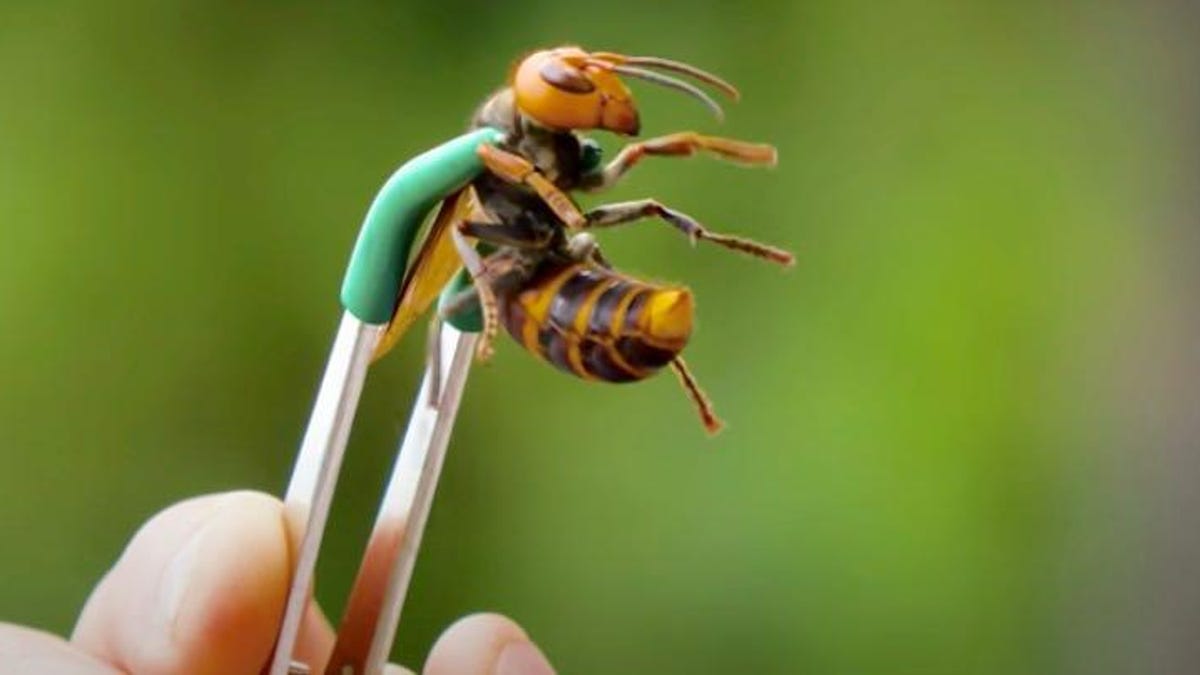Murder hornets are about to start their 'slaughter phase'
Washington State Department of Agriculture is searching for a nest of Asian Giant hornets before the deadly insects attack beehives.

Asian giant hornets, also called Murder Hornets, are up to two inches long, and can sting its victim multiple times.
Remember those pesky Asian giant hornets (nicknamed "Murder hornets") we reported on back in May? They were spotted in Washington state last year and, well, they haven't just disappeared. In fact, they could engage their search-and-destroy mode soon.
Before everyone panics, it's important to note that only six Asian giant hornets have been caught, trapped or reported since Sept. 21 in Washington state since they were first spotted last year. However, the murder hornet hideaway -- their nest -- was never located or destroyed.
Initially, researchers with the Washington State Department of Agriculture attempted to glue a radio tag on a live murder hornet, hoping they could follow it back to its nest. But sadly the glue failed and got into the hornet's wings, which meant the hornet couldn't fly home.
So the WSDA needs help in locating the nest to kill any remaining murder hornets before they transition into a much more aggressive mode: the Slaughter Phase.
Darn! We failed to post here on Twitter! Shame on us. Live #AsianGiantHornet caught this week, but our first tracking attempt was not successful. More info in our press conference recording: https://t.co/Arnm7IawzM pic.twitter.com/zKqhEo5a31
— WA St Dept of Agr (@WSDAgov) October 3, 2020
"Asian giant hornets this time of year start going into what we call the slaughter phase," Sven-Erik Spichiger, a WSDA entomologist, told the Seattle Times on Oct. 2. "They will visit apiaries, basically mark a hive, attack it in force, removing every bee from the hive, decapitating them, killing all of the workers, and then spending the next few days harvesting the brood and the pupae out of the hive as a food source."
The WSDA is still using a variety of ways to locate the Asian giant hornets. They have placed lure hives as bait around Birch Bay. This is around the same area where the first Asian giant hornet was trapped in Washington over the summer.
While these murder hornets might have a mission to destroy all bees, humans fortunately avoid their kill list in the slaughter phase.
#AsianGiantHornets are still being spotted in the Blaine area. Please stay on the lookout and report to @WSDAgov! https://t.co/cFgTzYDMgb
— Whatcom County Gov (@Whatcomctygov) September 29, 2020
Asian giant hornets have a nasty sting, but despite their nickname, murder hornets kill, at most, a few dozen people a year in Asia, and some entomologists say it's probably far less. The WSDA does stress not to be a hero or try to trap them yourself if you spot them flying around your backyard.
"Track it, don't whack it," Spichiger said. "We want to take out the nest so we don't have more next year."
The Asian giant hornet (Vespa mandarinia) is described as 1.5 inches to 2 inches in length with an orange-yellow head and black stripes on its abdomen. Thanks to their large size, the insects are pretty easy to spot.
Report all murder hornet sightings to the Washington State Department of Agriculture.
The department wants anyone who sees any potential Asian giant hornet to report it to them so researchers can better pinpoint where the insects have been hiding before the "slaughter phase" begins.
There are multiple ways people can report murder hornet sightings. Report using the Hornet Watch Report Form or email hornets@agr.wa.gov. If you don't have access to email or the internet, you can call them at (800) 443-6684.
Beekeepers who might have a beehive under attack by murder hornets should call (360) 902-1880 and let the department know which direction the hornets are flying so the nest can be found quicker.

